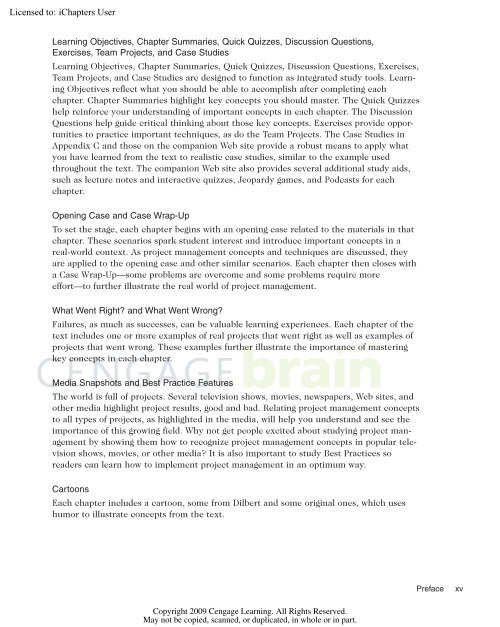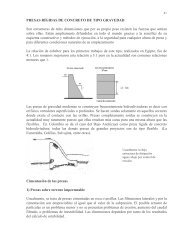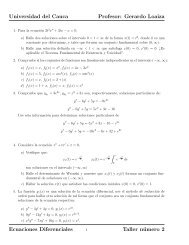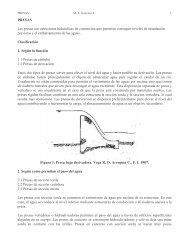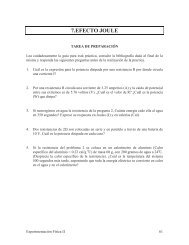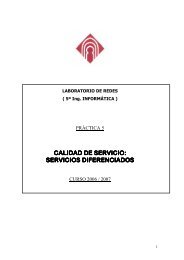Advice for the Project Management Professional (PMP)
Advice for the Project Management Professional (PMP)
Advice for the Project Management Professional (PMP)
You also want an ePaper? Increase the reach of your titles
YUMPU automatically turns print PDFs into web optimized ePapers that Google loves.
Licensed to:<br />
Learning Objectives, Chapter Summaries, Quick Quizzes, Discussion Questions,<br />
Exercises, Team <strong>Project</strong>s, and Case Studies<br />
Learning Objectives, Chapter Summaries, Quick Quizzes, Discussion Questions, Exercises,<br />
Team <strong>Project</strong>s, and Case Studies are designed to function as integrated study tools. Learning<br />
Objectives reflect what you should be able to accomplish after completing each<br />
chapter. Chapter Summaries highlight key concepts you should master. The Quick Quizzes<br />
help rein<strong>for</strong>ce your understanding of important concepts in each chapter. The Discussion<br />
Questions help guide critical thinking about those key concepts. Exercises provide opportunities<br />
to practice important techniques, as do <strong>the</strong> Team <strong>Project</strong>s. The Case Studies in<br />
Appendix C and those on <strong>the</strong> companion Web site provide a robust means to apply what<br />
you have learned from <strong>the</strong> text to realistic case studies, similar to <strong>the</strong> example used<br />
throughout <strong>the</strong> text. The companion Web site also provides several additional study aids,<br />
such as lecture notes and interactive quizzes, Jeopardy games, and Podcasts <strong>for</strong> each<br />
chapter.<br />
Opening Case and Case Wrap-Up<br />
To set <strong>the</strong> stage, each chapter begins with an opening case related to <strong>the</strong> materials in that<br />
chapter. These scenarios spark student interest and introduce important concepts in a<br />
real-world context. As project management concepts and techniques are discussed, <strong>the</strong>y<br />
are applied to <strong>the</strong> opening case and o<strong>the</strong>r similar scenarios. Each chapter <strong>the</strong>n closes with<br />
a Case Wrap-Up—some problems are overcome and some problems require more<br />
ef<strong>for</strong>t—to fur<strong>the</strong>r illustrate <strong>the</strong> real world of project management.<br />
What Went Right? and What Went Wrong?<br />
Failures, as much as successes, can be valuable learning experiences. Each chapter of <strong>the</strong><br />
text includes one or more examples of real projects that went right as well as examples of<br />
projects that went wrong. These examples fur<strong>the</strong>r illustrate <strong>the</strong> importance of mastering<br />
key concepts in each chapter.<br />
Media Snapshots and Best Practice Features<br />
The world is full of projects. Several television shows, movies, newspapers, Web sites, and<br />
o<strong>the</strong>r media highlight project results, good and bad. Relating project management concepts<br />
to all types of projects, as highlighted in <strong>the</strong> media, will help you understand and see <strong>the</strong><br />
importance of this growing field. Why not get people excited about studying project management<br />
by showing <strong>the</strong>m how to recognize project management concepts in popular television<br />
shows, movies, or o<strong>the</strong>r media? It is also important to study Best Practices so<br />
readers can learn how to implement project management in an optimum way.<br />
Cartoons<br />
Each chapter includes a cartoon, some from Dilbert and some original ones, which uses<br />
humor to illustrate concepts from <strong>the</strong> text.<br />
Copyright 2009 Cengage Learning. All Rights Reserved.<br />
May not be copied, scanned, or duplicated, in whole or in part.<br />
Preface xv


